With 16,000 students from Japan and abroad spread out over its three campuses, chances are you can find someone with any hobby or interest imaginable at Nagoya University. Find enough people who share one, submit your application to the university, and you can form a club. Every university has a tennis club, a choir, an art club...but a gliding club? That's something a little different.
A small group of Nagoya University students with a love of taking to the skies make up the Nagoya University Flying Club. Their wings are attached to one- and two-man gliders: small, lightweight aircraft with no engines which rely on air currents to sustain their flight after launch.
100km/h flight at 500 meters
So how do you get an aircraft with no engine off the ground? At the end of the runway there is a hefty winch, whose 1000 metre long wire is attached to the glider. The winch pulls the glider up to a speed of 90-110km/h (55-70mph), at which point the glider's wings generate sufficient lift to take flight. A normal flight takes place at an altitude of 400-500m at 80-90km/h, although some flights may reach altitudes of 2,000-3,000m if they catch the right air current. Theoretically, a glider could reach speeds of over 200km/h in the right conditions, but in practice this would run the risk of damaging the aircraft and is considered too risky, according to the club.
 The glider is pulled down the runway by a winch
The glider is pulled down the runway by a winch
With no engine to pull you out of trouble in adverse wind and weather conditions, learning how to pilot a glider safely is the highest priority. New members to the club take classes on safe flying, and are instructed on how to control the aircraft. Gliders have two main controls, a flight stick and pedals, to adjust their heading, attitude and speed.
Despite the simple controls, piloting a glider requires a lot of skill. Pilots need to keep an eye on wind direction and speed, terrain, and focus on following air currents. They need to have a good understanding of atmospheric pressure and other meteorological phenomena, and be able to respond quickly to changing conditions.
Following a successful launch and the securing of a current, flights of over an hour are possible. "When you catch a strong current, it feels like you're floating. A long glider flight is a special feeling," says club member and 2nd year science student So Nakagawa.
 View from the cockpit during a training flight
View from the cockpit during a training flight
First objective: get your license
The club has one single-seat and one two-seat glider. To fly solo, club members must obtain a personal aircraft license. As well as a written and practical examination, the license has experience requirements - pilots must have completed 30 take off and landing cycles, over 3 hours of solo flight, and demonstrate the ability to recover from a stall. Just obtaining this experience takes 2-3 years, during which time the trainee flies the two-seat glider with an instructor and attends classroom sessions.
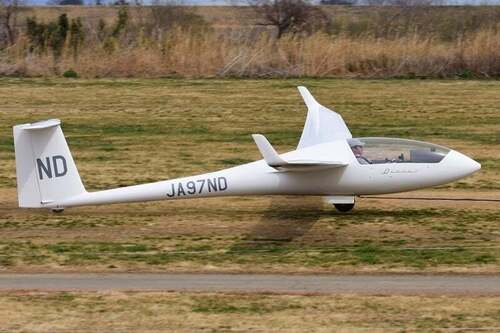
 Single-seat glider 'Sōyō' (above) and two-seater 'Haruka' (below)
Single-seat glider 'Sōyō' (above) and two-seater 'Haruka' (below)
Crucial but limited training time
Training is split between sessions on one of two simulators, and real world flight training. The club spends a few days each month at airfields in Gifu and Fukui Prefectures, flying from dawn to dusk to get in as many hours as they can.
As trainees need an instructor to fly with them, a few Nagoya University alumni with instructor qualifications volunteer to accompany the new members on their flights. "Without them taking the time out of their busy schedules to help us, we wouldn't be able to do what we do," says Nakagawa gratefully.
With flight also limited by weather conditions, lengthy seat time is far from guaranteed. "Pre-flight simulator training and preparation is really important. You need to be able to be calm, concentrate and make the most of your real world practice time," Hibiki Matsui, a 2nd year engineering student aiming to obtain his license this summer, explains.
 The members of the Nagoya University Flying Club
The members of the Nagoya University Flying Club
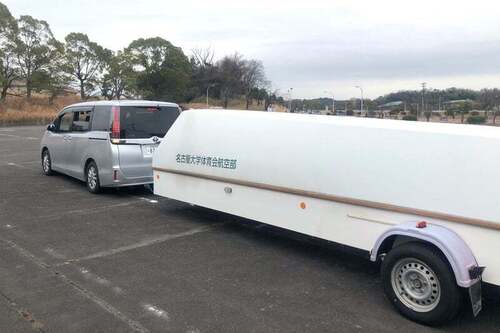 The huge trailer required to transport the glider to the airfield. Weighing in at 1280kg, one of the club members had to obtain a special driving licence to be able to tow it.
The huge trailer required to transport the glider to the airfield. Weighing in at 1280kg, one of the club members had to obtain a special driving licence to be able to tow it.
Nagoya University's world-first simulator
In one of the club rooms on the Higashiyama Campus, the club keeps something rather special - the world's only two-seat glider simulator, built by the club three years ago. Members use their free time between classes to pop in to the room and practice. As the only one of its type, the simulator is in high demand - other universities' flying clubs come to use it, and it has been displayed at the Aichi Museum of Flight.
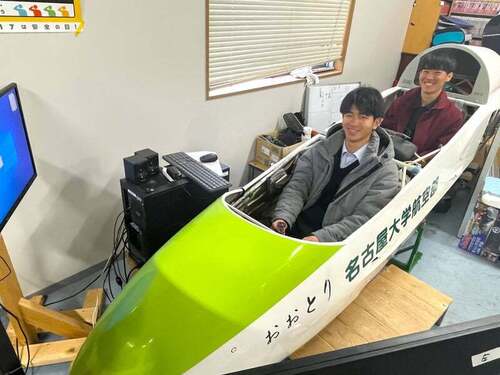 Club members Hibiki Matsui (front) and So Nakagawa (behind)
Club members Hibiki Matsui (front) and So Nakagawa (behind)
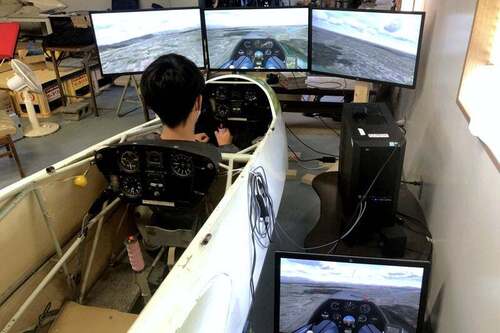 On top of regular flying practice, the simulator allows pilots to practice responding to emergency situations that would be dangerous to attempt in a real aircraft.
On top of regular flying practice, the simulator allows pilots to practice responding to emergency situations that would be dangerous to attempt in a real aircraft.
The heat of competition
Glider competition is broadly separated into three categories - highest speed around a course, number of times around a course, and overall flight time. At the annual tournament held between the seven former imperial universities, scores are decided based upon average speed and distance flown through the use of checkpoints and GPS data.
With flight opportunities being drastically reduced during the COVID-19 pandemic, recent years have seen some club members graduate without being able to obtain their licenses. For members who matriculated and joined the club in 2020 at the start of the pandemic, this year's contest will be their last. "I hope that we can end our time in the club with a victory and make those who were unable to compete before us proud," says Nakagawa.
Nagoya University has previously won the universities' tournament 7 times, from 2000-2006, and the national championship twice (2007 and 2011). We wish them the best of luck in bringing the trophy home once again this year*.
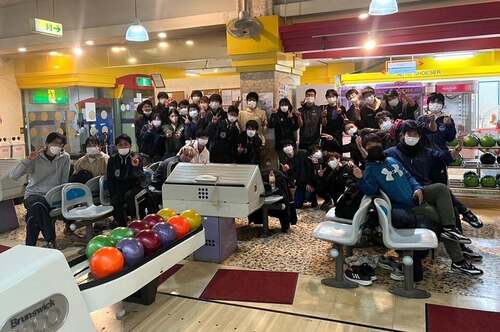 The bowling match to celebrate the end of the universities' tournament last year. Through their membership of the Flying Club, students have been able to meet others from across the country.
The bowling match to celebrate the end of the universities' tournament last year. Through their membership of the Flying Club, students have been able to meet others from across the country.
Translated by Edmund Rhind-Tutt, original Japanese article by Tatsuyuki Fukui. Thanks to the Nagoya University Flying Club.
*Update: the Nagoya University team finished second, a particularly brilliant result given the lack of flying time over the last few years. Congratulations!
